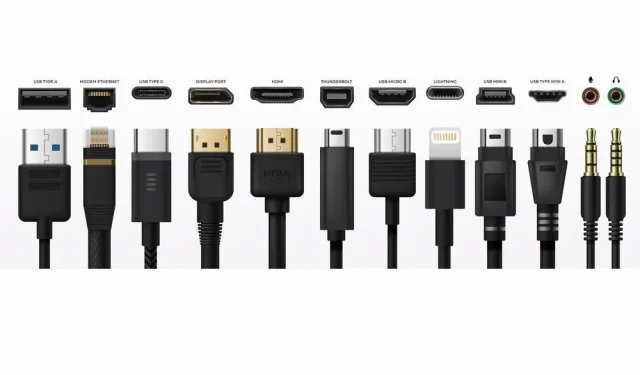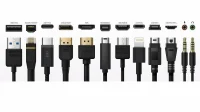With the development of technology, several versions of connectors and ports have become much more functional. It also helped create more portable devices that are easier to carry and use.
However, as technology has advanced, things have also become more complex as more features and complexities have been added. Most systems, especially computers and laptops, operate and communicate using USB (Universal Series Bus) ports.
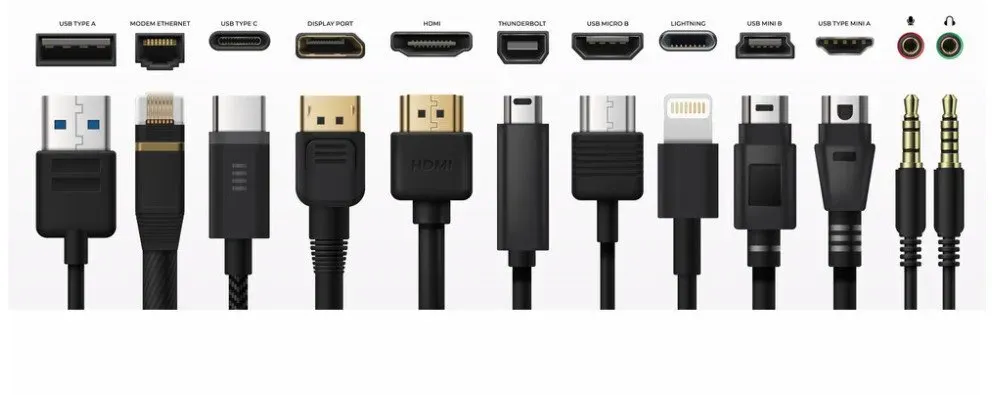
USB plug connector. Type-c port USB connector replacing micro and mini USB type A, MI hand-drawn 3.5mm jack charging connector and display port. Vector set of phone sockets printing cable illustration.
There may be times when data transfer is not possible if the ports and cable are not compatible. For these reasons, understanding the different types of ports and cables is essential, such as how to identify USB ports by their symbols.
What are USB symbols?
Since we already know the symbols that represent certain specifications, you may come across several symbols in a computer system that perform different functions. Similarly, there are USB symbols.
Since these USB symbols can be seen on almost every device, be it computers, laptops, phones, etc., understanding them is essential. The USB symbols represent the problems they can solve and the extensibility of the standard.
Like the other trident, the USB trident also represents technological power. However, each symbol component represents a separate possibility. The arrow usually represents serial data, which contains bits 1 and 0 to cover all information.
The voltage at which USB operates is also shown. USB operates at 5V and is represented by a circle, while a square represents the negative or ground voltage. As a result, the structure of the USB symbol is very significant.
Various USB ports and symbols
Typically, a USB port marked only with the USB symbol is a USB 2.0 port. USB ports labeled SuperSpeed or SS are usually a USB 3.0 port. However, if the USB port is labeled “SS10”, it is a USB 3.1 port.
In addition, there is a slightly different symbol that you may have come across. Some USBs have a charging symbol. This means that the port can take advantage of USB 3.0, allowing faster transfer speeds and allowing you to quickly charge your device even when the system is not turned on.

A lightning bolt symbol on a port indicates that it can only provide USB power. This is usually only used to charge other devices such as smartphones.
You can charge your device while the system is in sleep mode or when it is turned off. It also depends a lot on the type, model and manufacturer. The transfer speed will also affect your desktop computer or the USB you use.
Types of USB ports
Multiple USB ports on your tablets, computers and other devices will do. There are generally three types of ports. People prefer USB-C these days as new devices are compatible with it.
One of the main reasons is that it is considered to be the smallest port that transfers data faster and delivers up to 100W of power. USB-C is similar to Lightning, but the only thing is that it uses a slightly different connector.
USB-C cables can transfer 4K and 8K high-definition video. It will become a little easier for you to understand how high the transfer rate is once you get familiar with the design.
How to identify USB ports by their symbols on your laptop or computer
- Pass the technical task
- Check port color
- Define shortcuts
- Check out the motherboard specifications
1. Check out the technical specifications
Looking at the specifications will make it easier for you to identify the USB ports if you want to do so without checking the colors and logo. However, in order to use this method, you need to know your device’s built-in port so that you can find it as well.
On a Windows system, the process is pretty much the same for everyone. You can follow the steps below to determine the port from the technical specifications.
- Press the Windows key and R to open the Run dialog box. Typing “Run”in the search bar will help you open the same.
- Once you open the box, enter. “
devmgmt.msc“and press Enter. - Once you get to the Device Manager, look for the “Universal Serial Bus Controllers”option.
- If it’s a USB 2.0 port, you may see “Enhanced”in the description.
- However, if it’s USB 3.0, you’ll run into xHCI or an extensible host controller.
- Right-click it and open Properties. You can see more information about the USB port here.
As for the Macbook, you can follow a few steps to check the specifications and identify the symbols.
- You will see an Apple icon on the far left of the monitor. Click on it and select “About This Mac”from the drop-down menu.
- Click “System Report”and then select “More Information”.
- You can then select “Hardware”under the “System Information”tab.
- Then expand the USB tab.
You will be taken to the full list of available USB ports, where you can also find out the type of port. Once you can do that, it will be physically easier to connect the USB to your device.
2. Check the color of the port
Another easy way to identify a USB port is by color. Several ports are color-coded to give them a clear visual identity. In most cases, the blue ports are USB 3.0.
This distinguishes it from USB 2.0 as its interior is either white or black. However, USB 3.1 ports in new devices these days are red on the inside. At the same time, Always On ports are yellow.
If you managed to figure it out, it will be easier for you to understand and identify the port.
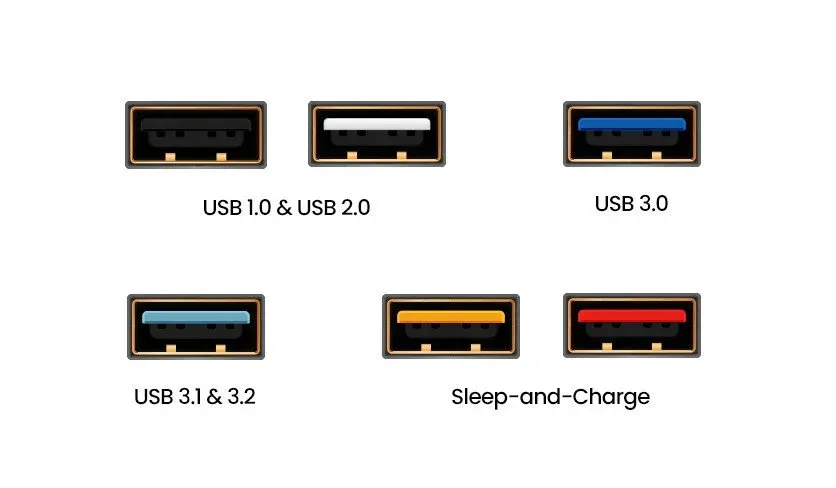
3. Define shortcuts
In most cases, labels such as 3.1, 3.0, 2.0, 11 and 1.0 are applied to the body of the device. With the help of symbols they can be appropriately marked. SuperSpeed USB is quite common among USB 3.0 ports and manufacturers label it accordingly.
Usually they are marked SS. However, if there is a lightning icon next to the USB port, it is an always-on port. This means that you can charge your device through this port even when the device is turned off.
Thus, the device charges faster as more power can be transferred.
4. Check the motherboard specifications.
Even though this method is a bit more complicated and tedious, you can check the specifications of your motherboard or laptop to understand or identify the USB port. Doing the same in this process also helps to find the exact model.
For windows, you can do the following.
- Open the Run dialog box by pressing Windows and R.
- Type “
msinfo32“in the field and press Enter. - Locate your system model in the System Information window.
- Click on it and type Ctrl+C.
- Paste it into any search engine and view the search results.
You can see the manufacturer’s webpage and once you’re there press CTRL and F and type USB. After that, you will see the port specifications in the list.
The process is the same for Macbook. However, you can still click the Apple icon in the top left corner of the screen. Click on the dropdown menu and select “About Mac”.
You can view system information, which will display the serial number, operating system version, and model name and number. Once you know which model you are currently using, it will be easier for you to determine the port using the technical specifications on the Internet.
Difference between USB 2.0 and USB 3.0
There is usually a visual difference between USB 2.0 and USB 3.0. This includes mostly color terms. USB 2.0 is usually black inside the USB port. In contrast, USB 3.0 inside the USB port is blue.
There are similar differences between USB 3.1 and 3.0. The block that is inside USB 3.1 is usually red. You also need to understand that there is a huge difference between USB and Thunderbolt.
Thunderbolt cable is faster than USB-C. The first can transfer up to 40 gigabytes of data per second. To achieve this speed, you must also use a Thunderbolt cable along with the Thunderbolt port.
Lightning, on the other hand, is like a standard USB-C port. However, in most cases, there is a lightning bolt icon next to it. You should also keep in mind that the absence of this icon on your USB-C port means that the advanced features of the Thunderbolt cable are not supported.
In addition, USB 3.0 also makes better use of energy. Typically, USB 2.0 draws only about 500 mA, while USB 3.0 reaches 900 mA. This will also result in shorter periods for phone devices, especially if you are trying to charge from your laptop or PC.
Types of USB connectors
- USB-A
- USB 3.0 type A
- USB 3.0 type B
- Internal USB 3.0 connector (20 pins)
- USB 31. Internal connector
- USB-B
- Mini USB
- Micro USB
- USB-C
- Lightning cable
- Portable USB connectors
1. USB-A
USB-A is also known as the standard USB A connector. It is commonly used on computer host controllers and hubs. The USB-A connector is intended to provide a “downstream”connection for host controllers and hubs, and is rarely used as an “upstream”connection.
This is mainly due to the USB host supplying 5VDC power to the VBUS pin. As a result, it’s important to remember that when shopping for USB cables, it’s best to make sure one of them must be USB A.
USB A male to male cables are used to connect two USB-A female ports. You have to be careful as standard AA cables are not designed to connect two host computers to a hub.
2. USB 3.0 type A
In addition to the Type A connector used in USB 2.0 and USB 1.1 applications, USB 3.0 A provides a “downstream”connection for hubs and “hot”controllers. However, USB 3.0 Type-A handles extra pins that USB 2.0 A Type does not.
The USB 3.0 connector is designed to support 5 Gb/s super-speed data transfer, while lower data rates can be transferred backwards compatible with USB 2.0 ports. USB 3.0 connectors are often blue or have an “SS”logo to distinguish them from previous generations.
3. USB 3.0 type B
You will encounter USB 3.0 Type B mostly on upstream ports, hubs, printers, and other USB peripherals. This connector and USB 2.0 can support the USB 3.0 SuperSpeed application. However, the speed data is comparatively low.
You also need to remember that the USB 2.0 B connector is not compatible with the USB 3.0 connector. This is mainly because there is a slight change to the fork replacement.
4. Internal USB 3.0 connector (20 pins)
Internal USB 3.0 patch cables designed by Intel are commonly used to connect external USB SS ports on the front panel to the motherboard. The internal 20-pin header contains two USB 3.0 signal paths, allowing for a maximum of two separate USB 3.0 ports.
However, this does not require you to share the channel data bandwidth.
5. Internal USB 3.1 connector
As mentioned above, internal USB 3.1 patch cables, also developed by Intel, connect motherboards to front panel USB ports. The new generation internal connector, like the previous USB 3.0 internal connector, has a 20-pin version.
This supports one Type C port or two Type A connections, but with a smaller form factor and stronger mechanical latch. An internal connector was also introduced with a 40-pin version of the connector to support two full-featured Type-C ports.
6.USB type B
The Type B connector, also known as the USB B connector, is for USB peripherals such as upstream ports on hubs, printers, and other devices. One of the inherent reasons for the development of USB B connectors was to allow the connection of peripherals without the risk of connecting two host computers.
Although the USB B connector is still in use today, it is slowly being replaced by more advanced USB connector types.
7. Mini USB
USB mini B connectors, similar to USB type B connectors but with a smaller form factor, are used on USB peripherals. The mini B plug defaults to 5 pins with an additional ID pin for USB On-The-Go support, allowing mobile devices and other peripherals to be USB hosts.
Originally designed for older smartphones, the micro USB connector has replaced the Mini USB connector as smartphones have also become sleeker and more compact.
Digital cameras now use the Mini-B connector as they are not certified for new devices and the mini connector series is produced in smaller quantities.
8. Micro USB
The smaller version of mini USB is the micro USB B connector. This allows you to connect to several other hubs and computers, which means it’s thin enough to connect to other mobile devices.
The micro B connector has 5 pins for USB OTG, making it easy to work with external drives, digital cameras and other peripherals. However, it should be noted that in order to enable the OTG function, the cable assembly implementation must be enabled through a dedicated wired connection.
On October 22, 2009, the International Telecommunication Union announced the inclusion of the Mirco-USB interface in the widespread Universal Charging Solution (UCS).
9. USB C
The USB-C or Type-C connector is the latest USB interface, debuting with the new USB 3.1 standard. Unlike the USB A and B connectors mentioned earlier, the USB Type C connector can also be used on several other devices and host controller ports.
There are many laptops and mobile phones with Type-C USB connectors on the market. The USB Type C connector supports USB 2.0, 3.0, 3.1 Gen 1 and Gen 2 signals.
The USB 3.1 Gen 2 CC cable can transfer data at speeds up to 10 Gbps, providing improved power delivery and support for alternative HDMI and DisplayPort protocols.
10 Lightning
Lightning cables are typically USB 2.0 cables that can be connected to an iPod, iPad, or iPhone via an AC adapter or USB port. Basically this is done either for charging or for synchronization.
Lightning cables have eight signal pins instead of the 30-pin dock connectors used in previous generations of Apple products. This reduction in size encourages Apple to opt for ultra-thin devices such as the iPhone 6 or iPhone 5.
The size is almost the same as the standard micro-USB connector, which is slightly larger than the first. Although Lightning cables are now 80 percent smaller than the previous model, they are much stronger and more durable.
Another advantage is that, unlike other cables, they can be connected in any way, which means they are double-sided. There is no definite right or wrong way to connect a cable.
11. Portable USB connectors
A device, rather than a computer, can function as a host for another device using this specification. A smartphone, for example, can read data from a flash drive. All Android devices do not support OTG. You’ll notice a micro-USB or USB-C connector if your device supports it.
Alternatively, use an adapter for full size USB ports. As previously stated, USB OTG has a Micro-Ab socket that has replaced the Mini-AB. This port is compatible with Micro-A and Micro-B connectors.
How to identify a USB 3.0 port
If you are trying to identify a USB 3.0 port on your computer or laptop, there are several ways to do this. First, if you recently bought your laptop or computer, chances are good that it will have one USB 3.0 port.
However, if your system is old, you may have more than one 2.0 port and only one USB 3.0 port. However, you can check and see if you have a USB 3.0 port or not, both on Windows and macOS.
For Windows, you can follow the steps below.
- Press Windows and R to open the Run dialog box, then type
devmgmt.mscand press Enter. - When you get to Device Manager, scroll through the list of Universal Serial Bus controllers and open the drop-down menu.
- If you see a host controller driver and a USB 3.0 entry, it means you have a USB 3.0 port.
For macOS, you can follow the steps below to identify the USB 3.0 port.
- Click on the Apple icon at the far left of the screen.
- Select “About This Mac”from the menu.
- Then click “System Report”.
- When the System Information menu opens, you can click on Hardware and check the USB tab.
Once you do that, you will see a list of Universal Serial Buses; if you have a USB 3.0 port, the same will be listed on this list.
Type of USB cables
USB or Universal Serial Bus cables are common and essential components of every electronic device, as their main purpose is to connect to various electronic devices. Technological upgrade follows the same trend that there are many types or versions of USB standards.
In addition to USB connectors, there are other types of cables. The first is the only type that mainly refers to the cable used in host devices. You also have to remember that this is not Type-A and is completely different from it.
The Type C cable has Type A and Type C connectors. For example, your Android phone will come with a micro-USB cable. What’s more, a Type A cable is when it has both male connectors, which are both Type A connectors.
Another type of cable is USB Type-A, the first type, and Type-C is the second type. If two connectors are of the same USB type, the cable will be labeled USB Type-C to USB Type-C.
USB functions
USB cables and ports can be used for multiple purposes, and there are more hubs and other peripherals with different functions.
USB peripherals are called USB functions. MP3 players, memory cards, cameras, keyboards, mice, and printers that a single host controller can support are examples of such devices.
USB hubs divide a single connection point, commonly referred to as a port, into multiple connection points to accommodate more peripherals. A USB hub is an essential component of a standard USB configuration, especially for laptops with a limited number and type of peripheral connectors.
USB docking stations or docking stations are interchangeable with USB hubs due to their similar appearance and functionality. Docking stations can be used to create a workstation by connecting a laptop, external monitor, laptop and other accessories.
These 5K docking stations also feature classic USB-A, and the USB connections that may be coming are perfect for desktops and laptops.
USB chargers deserve a mention due to the growing popularity of portable devices, tablets and smartphones that can be charged via USB. These power adapters provide the devices with five volts of power.
A Type-A connector is inserted into the body of the charger, and another connector, such as Type-C, is stuck into the device. USB charging ports are also common in public places such as malls, airports, etc.
Difference between USB-C and Thunderbolt 3
Thunderbolt is a registered trademark that provides high-speed charging along with data transfer. The first two versions are equipped with a Mini DisplayPort interface, and the third one is equipped with a USB connector.
According to a FAQ, Thunderbolt 3 ports are compatible with USB cables and devices. They can also work as high quality USB-C cables. You can also connect USB-C devices to Thunderbolt 3 ports, which will work properly.
However, you must remember that you will not be able to connect Thunderbolt 3 devices to USB-C ports. Thunderbolt chipset functionality is missing when it comes to the USB-C port.
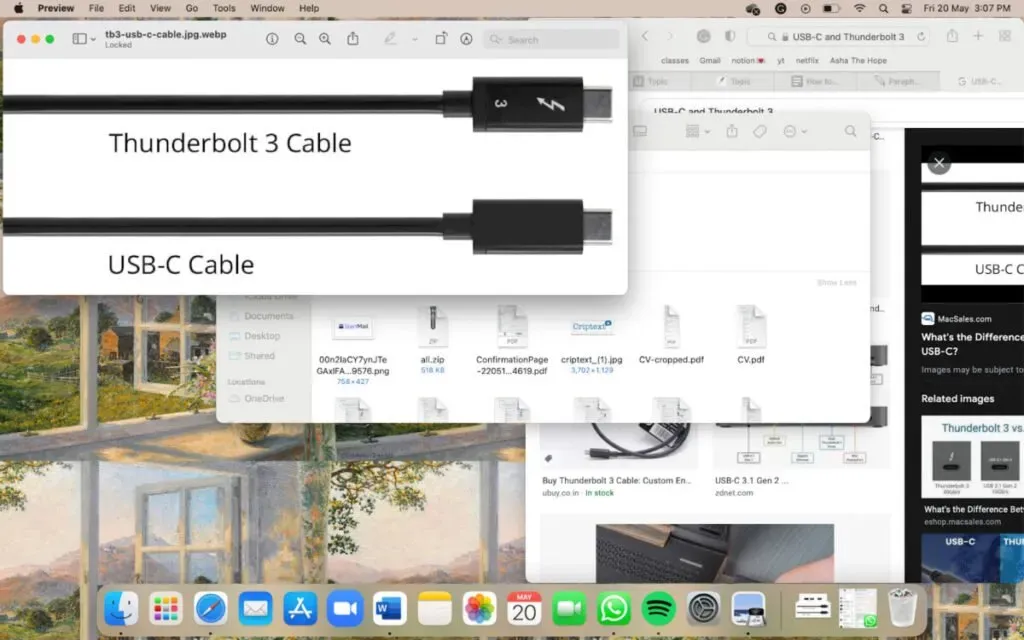
The simplest explanation is that USB-C refers to the port form while Thunderbolt 3 refers to the connection standard. Thunderbolt 3 is a USB-C connector that combines Thunderbolt, DisplayPort, power, and USB.
The Macbook Pro has a “Touch Bar”that typically connects to Thunderbolt 3 devices. Hardware known as USB-C devices will also work with a Thunderbolt 3 port. However, using the maximum speed provided by Thunderbolt 3 devices is not possible.
Conclusion
The appearance of the port or the USB logo can sometimes be confusing because you won’t be able to tell which USB port your system has. Therefore, you should keep a close eye on the desktops, USB hub, and physical hub during this time.
In addition, knowing and understanding the type of USB port and cable required for your system is essential for transferring data, charging other devices, and connecting external hard drives. Therefore, identifying USB ports simply by symbols is an easy way to do this.
As mentioned earlier, there are several other ways to identify a USB port. Some of them are related to colors, specifications and the like. Once you figure out which character is for which USB port, transferring data and other activities becomes easier for you.
FAQ
How to identify the USB 3.0 port and connector?
There are several ways to identify a USB 3.0 port and connector. In most cases, you can only tell by looking at the color, since USB 3.0 ports are usually blue, either inside or around the connector. Also, if you notice any symbol, it will either be labeled as 3.0 itself or as SS which stands for SuperSpeed USB. If you cannot identify a USB 3.0 port, you can view the specifications to check the list of USB ports on your computer system. If you see a USB 3.0 port in the list of Universal Serial Bus controllers, you can be sure that your system has and should be connected to a USB 3.0 connector.
How to determine which USB port is which?
Since USB ports look the same, they can be distinguished in several ways. You can check the logos that are present. USB 2.0 has either a white or black interior. However, these days, the inside of the USB 3.1 ports on newer devices are colored red. However, Always On ports are yellow. A USB 2.0 port typically only has the USB symbol. USB ports labeled SuperSpeed or SS are usually USB 3.0 ports. If the port is labeled SS10, it means that it is a USB 3.1 port.
How to determine USB port numbers?
To determine the DeviceID number for USB devices, also known as the USB port number, you need to check the specifications. You will need to go to search on your computer and type in Powershell. Once you’ve done that, right-click it and choose “Run as administrator”.
What do the symbols on USB ports mean?
The symbols on the USB ports let you know which USB cable is more compatible with your computer system. The trident with prongs ending in squares, circles, and triangles are symbols on USB ports. These three forms are thought to represent the numerous devices that a USB connection can support. The first rectangular USB-A port solved a major problem by allowing us to connect all of our peripherals with a single connector. Because it delivers faster data, power, and video transfers in a smaller package, the slim oval USB-C is fast becoming the universal standard. After that, you will need to enter gwmi Win32_USBControllerDevice |%{[wmi]($_.Dependent)}| Sort Manufacturer,Description,DeviceID | Ft -Group According to manufacturer’s description, service, device ID.
Where is COM port 1 on my computer?
You can follow the below steps to enable COM port in UPort in Windows. You can open Device Manager on your computer. – You can then connect to the host computer via the UPort. – Open the Universal Serial Bus controllers through Device Manager. You will need to right-click on the communication port and select Properties. – Click the Port Configuration tab in the Properties window and click Port Configuration. – From the drop-down menu, select COM2 as the native COM port in the Port Number field, then click OK. – You can click the OK button again in the properties window. – The native COM port number in Device Manager must be changed to COM2. – Connect your UPort 1100 series to the host. – On your host, open Device Manager and select the Ports (COM and LPT) option.
